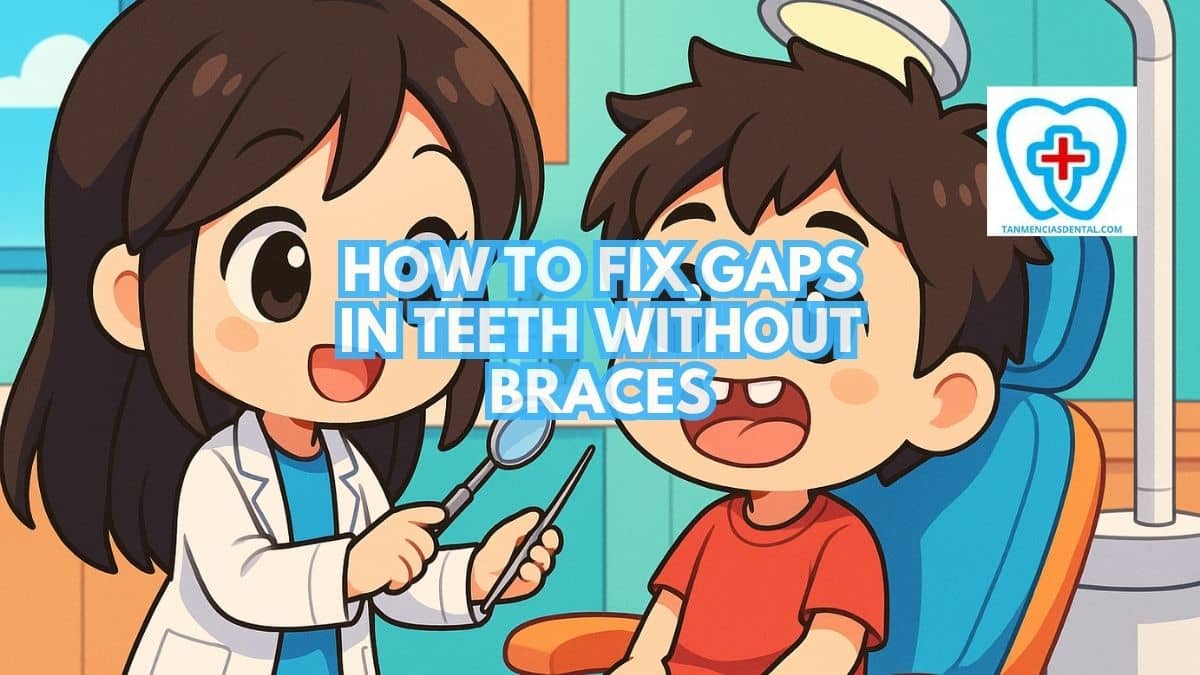Gaps between teeth, called diastemas, can happen for many reasons, such as missing teeth, small teeth, or habits like thumb-sucking.
Some people are okay with them, but others want to change the way their smile looks.
Gaps can also cause problems like food getting stuck, speech issues, or biting trouble.
Many people want to fix gaps without using braces because braces can be slow, costly, or uncomfortable.
We’ll explain different ways to close gaps, so you can make a choice that fits your needs.
1. Dental Bonding: Quick, Affordable, Minimally Invasive
Dental bonding is a fast and simple way to fill small gaps using a tooth-colored material.
The process is often done in a single visit, with no need for drilling or removing tooth enamel.
Bonding is cheaper than other treatments, but the material can chip or stain over time.
It’s best for small gaps and might need to be redone every few years.
Bonding doesn’t change your teeth permanently, which can be a benefit if you’re not ready for a long-term solution.
🦷 Can You Really Learn How To Fix Gaps In Teeth At Home Safely?
2. Porcelain Veneers: Durable, Natural-Looking, Irreversible
Porcelain veneers are thin covers placed on the front of teeth to make them look smooth and even.
Veneers last much longer than bonding, usually around 10–15 years, and they resist stains well.
However, the process removes a small amount of enamel, which is a permanent change.
Veneers are more expensive than bonding but are stronger and give a more natural appearance.
They work well for bigger gaps or when you also want to improve the shape and color of your teeth.
🦷 How to Fix Gaps in Your Teeth With Veneers, Bonding, or Aligners
3. Clear Aligners: Discreet, Removable, Require Consistent Use
Clear aligners are clear plastic trays that fit over your teeth and move them slowly over time.
They are nearly invisible, so most people won’t notice you’re wearing them.
You can remove them when eating or brushing, but you must wear them for 20–22 hours a day for the best results.
Clear aligners work well for small and medium gaps but may not fix large gaps or complex issues.
They require discipline, as not wearing them enough can lead to slower progress or no results at all.
🦷 How Does Wisdom Teeth Pain in the Ear Occur and What Are the Signs?
4. Dental Implants And Bridges: Permanent, Surgical, For Missing Teeth
Dental implants and bridges are solutions for gaps caused by missing teeth, not just small spaces between teeth.
Implants involve placing a metal post into the jawbone, topped with a crown, while bridges use nearby teeth to support an artificial tooth.
These treatments are permanent but require surgery and time to heal.
They help restore the ability to chew and speak well, while also improving appearance.
Implants and bridges are best for filling large gaps left by missing teeth, not small spaces.
🦷 Do You Brush Your Teeth Before Whitening Strips?
5. Teeth Gap Bands: Low-Cost DIY, Risky, Potential Damage
Teeth gap bands are small elastic bands sold online as a quick fix for gaps.
While they might seem like a simple solution, they can cause serious harm by moving teeth too fast or damaging gums.
Bands can lead to infections, loose teeth, or even tooth loss in some cases.
Dentists strongly advise against using them because they are unsafe and unpredictable.
It’s always better to seek a safe, professional treatment to avoid long-term problems.
🦷 Why Do Wisdom Teeth That Grow Sideways Cause So Much Discomfort?
6. Gap Size And Cause Influence Treatment Options
The size of the gap and why it formed play a big role in picking the best solution.
Small gaps from natural spacing may be closed with bonding or clear aligners.
Larger gaps or gaps from missing teeth usually need veneers, implants, or bridges.
Gaps from small teeth or uneven sizes might be fixed with bonding or veneers.
A dentist will check your teeth and gums to recommend the best approach for your specific situation.
🦷 When Do Wisdom Teeth Grow? Why Do Wisdom Teeth Grow at Different Times for Everyone?
7. Longevity And Maintenance Vary By Solution
Different treatments last for different amounts of time and need different care.
Bonding might last only a few years, while veneers or implants can last over a decade with good care.
Clear aligners must be worn as directed until treatment is complete, and implants or bridges need regular brushing, flossing, and dental checkups.
No matter which option you choose, taking care of your teeth is important for keeping your smile healthy.
Long-term care and proper habits make a big difference in how well your treatment lasts.
🦷 How to Fix Front Teeth Gap Without Braces
8. Aesthetic Improvements Vs Functional Corrections
Some treatments focus on improving how your smile looks, while others also help you chew or speak better.
Bonding and veneers mainly improve appearance but don’t fix bite issues.
Clear aligners can close gaps and help with mild bite problems, while implants and bridges restore chewing function when teeth are missing.
Think about what you want to achieve before picking a treatment.
Your dentist can help you decide if you need a cosmetic fix, a functional improvement, or both.
🦷 What Happens When You Don’t Brush Your Teeth With Braces?
9. Professional Dental Consultation Essential
Seeing a dentist is the best way to choose the right solution for your teeth gap.
A dental checkup lets the dentist examine your teeth, gums, and bite to recommend the safest option.
They can explain the benefits, risks, and costs of each treatment.
Getting advice from a professional helps avoid mistakes that could harm your teeth.
Always talk to a dentist before starting any treatment for gaps.
🦷 How Does a Teeth-Whitening Light Work to Brighten Your Smile?
10. Cost And Treatment Duration Differences
Each option has a different price and timeline.
Bonding is usually the cheapest and fastest, while veneers and implants cost more and take longer.
Clear aligners may take several months to a year, depending on the size of the gap.
Teeth gap bands are very cheap, but they can harm your teeth and are not a safe option.
Think about your budget, how much time you have, and whether the method is safe when deciding how to fix your gap.
🦷 Premier Dental Clinic Marikina
👨⚕️ Conclusion
Fixing gaps in teeth without braces is possible, but choosing the right option is important.
Each method has pros and cons that affect your teeth in different ways.
A dental professional can help you decide which solution fits your goals, budget, and needs.
Whether you care more about looks, function, or cost, there’s likely a good choice for you.
With the right treatment and care, you can feel confident in your smile.
😊 Self-Promotion
Visit Tan-Mencias Dental Clinic at 44 G. Del Pilar Street, Parang, Marikina City for expert dental care in a friendly setting.
We are happy to help you with any questions or concerns about your teeth and smile.
You can reach us by phone at 0917-145-1074, send a message through our Facebook page, or send us a message through our website.
We’ll do our best to answer quickly and make sure you feel cared for.
Your healthy, happy smile is always our priority!

